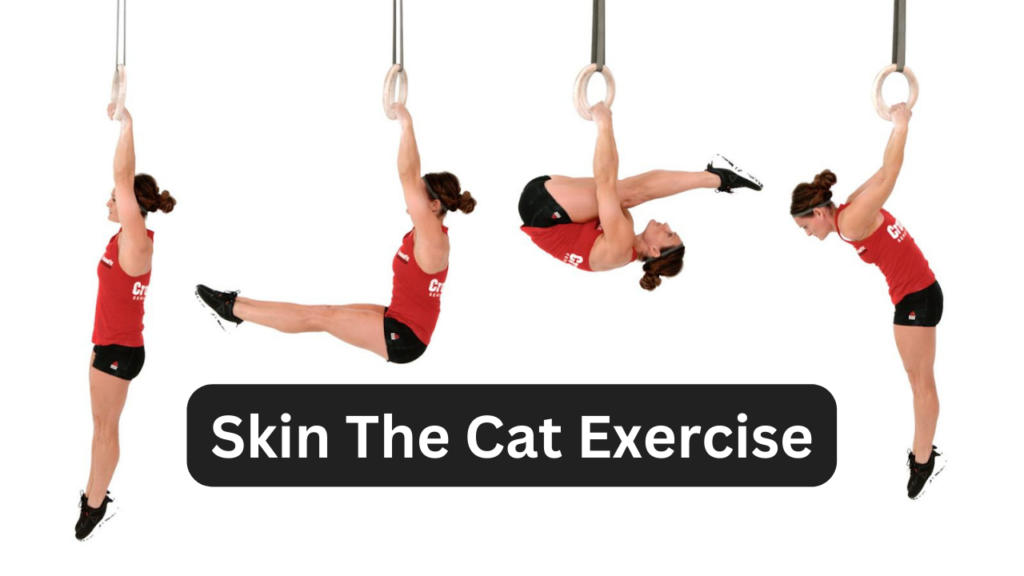The skin-the-cat exercise is a challenging calisthenics move that demands both strength and flexibility. It’s not for the faint of heart, but for those willing to put in the work, it offers a potent blend of benefits. From sculpting your core and shoulders to enhancing mobility and coordination, mastering the skin of the cat can take your fitness to the next level. This in-depth guide will equip you with everything you need to know about the skin the cat exercises, from proper technique variations to safety tips and progressions.
Whether you’re a seasoned athlete or just starting your fitness journey, we’ll help you navigate this dynamic movement and unlock its full potential. So, let’s dive in!
Understanding the Skin of the Cat
The skin of the cat, also known as the hollow body inverted hang with rotation, is a dynamic exercise that challenges your entire upper body. It involves transitioning from a dead hang position to an inverted hang while rotating your body around a horizontal bar.
This movement engages several muscle groups, including:
- Core: The core muscles, particularly the rectus abdominis, obliques, and transverse abdominis, work overtime to stabilize your spine and control the rotation.
- Shoulders: The deltoids, rotator cuff muscles, and serratus anterior are all actively involved in pulling you up and controlling the movement through the shoulders.
- Forearms and grip: Your forearms and grip strength are crucial for maintaining a secure hold on the bar throughout the exercise.
Benefits of Mastering the Skin of the Cat

The skin of the cat offers a wealth of benefits for overall fitness and well-being. Here are a few key advantages:
- Enhanced core strength and stability: The demanding rotational movement strengthens your core muscles, leading to better posture, improved balance, and reduced risk of back pain.
- Increased shoulder strength and mobility: The skin of the cat works your shoulders through a full range of motion, promoting strength, flexibility, and stability in this crucial joint.
- Improved grip strength: Maintaining a strong grip throughout the exercise strengthens your forearms and improves overall grip strength.
- Boosted coordination and control: The complex movement requires precise coordination and control of multiple muscle groups, enhancing your overall body awareness and control.
- Functional movement patterns: The skin of the cat mimics natural human movement patterns, like climbing or pulling yourself up, translating into improved functional fitness.
Before You Begin
Remember, the skin of the cat is an advanced exercise. It’s crucial to have a solid foundation of strength and flexibility before attempting it. Here are some prerequisites:
- Strong core: You should be able to perform exercises like planks and dead bugs with good form and control.
- Upper body strength: You should be able to perform pull-ups and rows comfortably.
- Shoulder mobility: You should be able to comfortably reach your fingers overhead with good shoulder mobility.
If you’re new to calisthenics or lack the necessary strength and flexibility, it’s recommended to start with simpler exercises and gradually progress toward the skin of the cat.
Mastering the Technique Step-by-Step Guide
Now, let’s break down the proper technique for performing the skin-the-cat exercise:
Start in a dead hang:
- Grip a pull-up bar or gym ring with an overhand grip, shoulder-width apart.
- Engage your core and maintain a straight body with your toes pointed.
- Relax your shoulders and keep your gaze slightly forward.
Tuck your knees to your chest:
- Bend your knees and bring them up towards your chest, engaging your lower abs.
- Keep your upper body straight and avoid swinging.
Initiate the rotation:
- As you reach the peak of the knee raise, begin to rotate your body over the bar by pushing your shoulders down and back.
- Keep your chin tucked and core engaged throughout the movement.
Transition to the inverted hang:
- Continue the rotation until your body passes through the bar and you end up in an inverted hang position with your legs straight and toes pointed.
- Maintain a tight core and squeeze your shoulder blades together.
Reverse the rotation and return to the dead hang:
- Slowly reverse the movement, rotating your body back under the bar and extending your legs back to the starting position.
- Focus on controlled movement and keep your core engaged throughout the return phase.
Variations and Progressions for the Skin of the Cat

While the full skin of the cat is a challenging feat, several variations and progressions can help you build towards mastering it or adapt it to your current fitness level. Here are some options to explore:
- Assisted Skin the Cat: Use resistance bands or a spotter to assist in the pull-up and rotation phases. This can be particularly helpful for beginners or those with weaker upper body strength. You can also start with a slanted bar or rings set at a higher angle, making the movement slightly easier.
- Hanging Knee Raises: Focus on the first phase of the movement by simply performing hanging knee raises. This strengthens your core and shoulders, preparing you for the full rotation later. You can also try hanging leg raises with straight legs for an added challenge.
- Tucked Inverted Hang Progressions: Practice holding a static tucked inverted hang position for increasing durations. This builds shoulder and core strength and familiarizes you with the inverted position.
- Once comfortable, try slowly lowering your legs from the tucked position towards a straight-leg inverted hang.
- Skin the Cat with Leg Cross: Add a twist to the movement by crossing your legs at the ankles as you rotate through the bar. This increases the coordination and core engagement required.
- Skin the Cat on Rings: Performing the skin of the cat on gym rings adds an element of instability that further challenges your core and shoulder stability. Be prepared for more micro-adjustments and dynamic control compared to a fixed bar.
Safety Tips
- Always listen to your body and avoid pushing yourself beyond your limits.
- Start with lighter variations and gradually progress to the full movement.
- Warm up properly before attempting the skin the cat, focusing on dynamic stretches and shoulder mobility exercises.
- Maintain proper form throughout the exercise to avoid injury.
- Use a spotter or assistance if needed, especially when trying the full movement for the first time.
- If you experience any pain, stop the exercise immediately and consult a healthcare professional.

Remember, consistency and proper technique are key to mastering the skin of the cat. Don’t rush the process; enjoy the journey, celebrate your progress, and feel empowered as you conquer this challenging yet rewarding exercise.
Beyond the Skin the Cat Exploring Calisthenics
The skin of the cat is just one piece of the vast and dynamic world of calisthenics. If you’re inspired to delve deeper, here are some resources to continue your exploration:
- Online calisthenics programs and tutorials: Numerous websites and YouTube channels offer structured calisthenics programs and detailed exercise tutorials.
- Calisthenics communities and forums: Connect with other calisthenics enthusiasts online or in local groups to share experiences, ask questions, and stay motivated.
- Professional calisthenics coaches: Consider working with a certified calisthenics coach for personalized guidance and training plans.
Remember, calisthenics offers a rewarding path to building strength, flexibility, and control using your own body weight. Embrace the challenge, have fun, and enjoy the journey towards a fitter and more empowered you!
Resources & References
- American Council on Exercise: https://www.acefitness.org/resources/everyone/exercise-library/
- National Strength and Conditioning Association: https://www.nsca.com/certification/continuing-education/quizzes-and-assessments/ceu-quizzes/glenohumeral-extension-and-the-dip/
- ExRx.net: https://exrx.net/Articulations/Shoulder
- GymnasticBodies: https://www.gymnasticbodies.com/
- Reddit Calisthenics Community: https://www.reddit.com/r/bodyweightfitness/wiki/index/
FAQs About the Skin the Cat Exercise
What are the benefits of the skin-the-cat exercise?
The skin of the cat packs a powerful punch when it comes to fitness benefits. Here are some key advantages:
- Enhanced core strength and stability: The demanding rotational movement strengthens your core muscles, leading to better posture, improved balance, and reduced risk of back pain.
- Increased shoulder strength and mobility: The skin of the cat works your shoulders through a full range of motion, promoting strength, flexibility, and stability in this crucial joint.
- Improved grip strength: Maintaining a strong grip throughout the exercise strengthens your forearms and improves overall grip strength.
- Boosted coordination and control: The complex movement requires precise coordination and control of multiple muscle groups, enhancing your overall body awareness and control.
- Functional movement patterns: The skin of the cat mimics natural human movement patterns, like climbing or pulling yourself up, translating into improved functional fitness.
Is the skin of the cat exercise safe?
While the skin of the cat offers numerous benefits, it’s crucial to prioritize safety during this exercise. Here are some safety tips:
- Start with easier variations: If you’re new to the movement, begin with assisted versions like hanging knee raises or the tucked inverted hang before progressing to the full skin the cat.
- Maintain proper form: Focus on controlled movements and engage your core throughout the exercise to avoid injury.
- Warm up properly: Prepare your body with dynamic stretches and shoulder mobility exercises before attempting the skin the cat.
- Listen to your body: Don’t push yourself beyond your limits and stop the exercise if you experience any pain.
- Seek guidance: Consider working with a certified trainer or calisthenics coach, especially if you’re new to the movement or have any limitations.
What are some common mistakes to avoid while doing the skin of the cat?
Here are some common mistakes to be mindful of when performing the skin the cat:
- Rushing the movement: Take your time, focus on controlled movements, and avoid jerky motions.
- Neglecting your core: Keep your core engaged throughout the exercise to maintain stability and prevent injury.
- Rounding your shoulders: Maintain straight elbows and avoid hunching your shoulders during the movement.
- Swinging excessively: Focus on controlled movements rather than using momentum to pull yourself through the exercise.
- Ignoring pain: If you experience any pain, stop the exercise immediately and consult a healthcare professional.
What are some progressions for the skin-the-cat exercise?
Once you’ve mastered the basic skin of the cat, you can challenge yourself further with various progressions. Here are a few options:
- Skin the cat with a leg cross: Add a twist by crossing your legs at the ankles as you rotate through the bar. This increases the coordination and core engagement required.
- Skin the cat on rings: Performing the skin the cat on gym rings adds an element of instability that further challenges your core and shoulder stability. Be prepared for more micro-adjustments and dynamic control compared to a fixed bar.
- Advanced variations: Once you’ve conquered the basic progressions, explore more advanced variations like the L-sit skin of the cat or the tuck-to-planche skin of the cat.
What if I don’t have access to a pull-up bar or gym rings?
Don’t fret if you don’t have access to traditional equipment! You can still reap the benefits of the skin of the cat with bodyweight variations:
- Hanging leg raises: Focus on the first phase of the movement by simply performing hanging leg raises. This strengthens your core and shoulders, preparing you for the full rotation later.
- Incline hanging variations: If you have access to a sturdy beam or inclined surface, you can perform the skin of the cat on an incline, making the movement slightly easier.
- Assisted variations: Use resistance bands or a sturdy chair to assist in the pull-up and rotation phases. This can be particularly helpful for beginners or those with weaker upper body strength.


